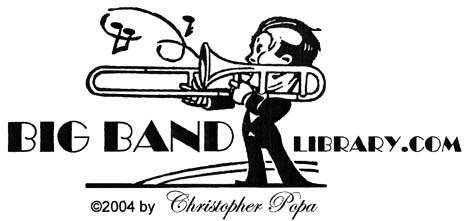
the big bands are back
in a new and exciting way
“I think he would like to be remembered as a person who always found and encouraged new talent,” Cindy proposed. “It happened throughout his career . . . He was a very good friend of Ed Sullivan’s and I know that when he was . . . about to preview Elvis Presley, he called him and ‘What do you think?’ My grandfather thought that everybody deserved a chance. It may not be what I would do. You know, 'It may not be my kind of music, but you know what – no one understood me in the beginning either.' It was the same thing when the Beatles came. Everybody’s going, like, ‘Oh my God!’ And [ Whiteman said ] ‘Oh, give them a chance!’ It’s kind of fun for me, now, in hindsight, to look back on that and go 'Hmmm.'"
For instance, Whiteman announced plans in 1956 to sponsor and emcee a rock and roll concert at Westport Stadium in Baltimore, MD, featuring the pop group Bill Haley and the Comets.
"But if anything," Cindy went on, "I think he would want to be known as a person who gave everybody a chance, whether he understood it or not. What he always looked for was that you had some key component of being musically correct, that you had some clue about what you were doing. But he didn’t seem to judge people based on whether it was what he would do or not. He always said, ‘Everybody needed a chance.’ So I think, more than anything, that’s what he would want to be known for."
As for his own music career, Whiteman wound it down by conducting an evening of Gershwin at the Lambertville, New Jersey Music Circus in 1960, and playing a month's engagement in Las Vegas in 1962.
"I’ve just gotten back from the New Hope, Pennsylvania area where he retired and talked to people there that remembered him," Rayno interjected, "and they said you know what really stands out to them is he just wanted to be ‘one of the boys.’ He just wanted to be one of the townspeople, and he did. I mean, he just hung around with people. So I don’t think he was ever really desirous to, sort of, be looked up to, to the degree that maybe he was then. But he really just enjoyed talking to the stagehands, backstage, and that kind of thing. When he retired, the things he liked to do were outdoors things. He liked to go skeet shooting with the men from the village… duck hunting… he raced cars – he was very involved in NASCAR. When he was 70, he was racing cars at Daytona!"
Whiteman, in fact, was a director of Daytona Speedway in Florida and several other well-known tracks.
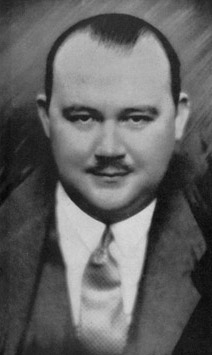
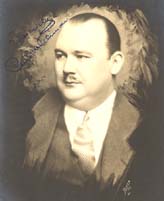
PAUL WHITEMAN
SOMETHING TO
REMEMBER YOU BY
by Music Librarian CHRISTOPHER POPA November 2007
After jazz began to flourish in the 1920s, the press touted him as "The King of Jazz," even though he appreciated and performed many kinds of music. With greater accuracy he would have been called "King of the Jazz Age," for his orchestra became the most popular of that decade.
"I think that he really established the big band concept, taking a big band and developing it," Don Rayno, author of the impeccable Paul
Whiteman: Pioneer in American Music, Volume 1
1890-1930 (Lanham, MD: The Scarecrow Press, Inc., 2003), told me. "He was the first to use special arrangements, and he really defined and led the way in how you take a band on the road, for example. All the logistics involved in that . . . He pioneered in many ways. That’s why I felt that ‘Pioneer’ was a good title. I think he would like to be remembered as a pioneer. That was what he was."
two portraits
of Whiteman, ca.1925
"I guess what surprises me more than anything is that he’s been forgotten,” Rayno
continued. "That just shocks me, only because I’ve delved into his life so much, seeing how important he was in his day. I guess that’s a lesson to all of us, that fame is a fleeting thing."
Whiteman was a big supporter of American music; most famously, he commissioned George Gershwin to write Rhapsody in Blue, and he and his band (with Gershwin as guest pianist) premiered it at Aeolian Hall in New York City on February 12, 1924.
"Certainly, the Rhapsody in Blue was one of his pride and joys that he had something to do with," Rayno agreed. "He never would claim that he had anything to do with writing that . . . but the fact that he introduced it and encouraged its writing . . . was a big area for him."
Likewise, all during his career as a respected bandleader, Whiteman sought out and gave high-profile opportunities to some of America's best musicians, composers, arrangers, vocalists, and entertainers.
"He had an incredible ear and an eye . . . for talent. He could spot it, and then he knew how to encourage talent." Rayno observed. "That's one reason you see so many people came up through his orchestra. But he really had a passion for that - that will really come out in the second volume more, Chris, because he began to do a lot more auditioning for talent; he would go to a city and hold auditions to try to discover young talent. And then give 'em a chance with a radio broadcast and that kind of thing. He really liked that. That was his passion right up through... even in his retirement years (if you call them retirement years), he was doing the 'Paul Whiteman Teen Club' in the '50s. That, certainly, no doubt, is one of his premiere accomplishments that really should be pointed to and emphasized. He really was a great purveyor of talent and also one who . . . got it going."
However, today, the average person wouldn't even recognize Whiteman's name.
"Unless they’re a real big band follower, that kind of thing. That’s unfortunate," Rayno allowed. "So one reason I really wanted to do this was to really get down the accomplishments, everything I could, about Paul Whiteman. I figured, well, if I don’t do it, it may never get done. Over time, information gets dispersed, and so on. So anyway, I’m laboring away at it.”
vital stats
given name Paul Samuel Whiteman
nickname "Pops"
birth Mar. 28, 1890, Denver, CO
death Dec. 29, 1967, Doylestown, PA, "acute
coronary attack" [ i.e., heart attack ]
heritage Scotch-Irish-English-Dutch extraction
father Wilberforce James Whiteman, supt. of
music for the Denver public school system,
b.Sept. 1, 1857, d.1939
mother Elfrida M. Dallison, a singer, b.1866?,
m.Dec. 4, 1883, d.June 26, 1934, "after a long
illness"
sister Ferne, b.1886, d.Dec. 24, 1953
education Denver public schools
faith Protestant
wife Nellie Stack, a chorus girl, b.1892?, m. Aug.
27, 1908, div. Jan. 19, 1914
wife Jimmy Smith, a showgirl, m.May 11, 1917,
div.1922
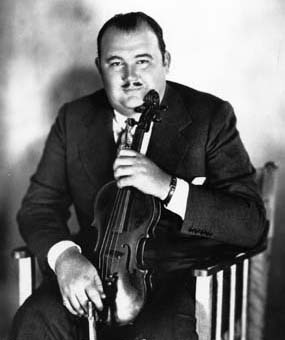
Whiteman, 1926
wife Mildred "Sadie" Vanderhoff (later, "Vanda Hoff"), a dancer, m.1922, div.1931
son Paul Jr., b.1924
wife Margaret Livingston, a silent-era film actress, b.1896?, m.Aug. 18, 1931,
d.Dec. 13, 1985
daughters Margot, b.1934; Julie; Jan
military service U.S. Navy, 1918
hobbies raising and showing livestock; auto racing
residences "Walking Horse Farm," Rosemont, NJ ( 1950 ); "Coda Cottage," New Hope, PA
( 1961 )
physical description 6 ft., 300 lbs. ( 1920s ), black hair, and a thin black moustache
His parents gave Whiteman a violin as a young boy in 1897, but he resisted becoming a serious musician until a teenager.
"Yeah, that's roughly when he got into it, as a 16 year old with the Denver Symphony, in that period," Rayno confirmed.
In April 1914, Whiteman left home and moved to San Francisco. Not long afterwards, he began working there with Max Bendix's Exposition Orchestra, then joined the San Francisco Symphony.
Despite these credentials, some historians have questioned Whiteman's abilities as a violin and viola player.
"You know, there's been a variety of opinions expressed on that, Chris," Rayno acknowledged. "He was quite talented. I mean, he played in two symphonies - he played in the San Francisco Symphony, and, before that, in the Denver Symphony. But he also played in the Minetti String Quartet . . . considered the best on the West Coast at the time, a period of about 1916, 1917, right in there. They didn't just hire anybody. He played viola in that. So he certainly had talent. And I think that, technically, he was a better string player than people have given him credit for. He must have been very well versed in violin and viola playing with symphonies."
Certainly with his father being a music teacher, Whiteman couldn't have slid by.
"He had a lot of lessons as a young man," Rayno reported. "I just recently . . . came across some other people that he studied with, that I'm going to include in the second volume. His father was top-notch, so he put him through the paces, I'm sure. He was trained well."
While in San Francisco, Whiteman met and became friends with Art Hickman, who led a local 10-piece dance band. Together they discussed emerging kinds of popular music, and he tried to encourage Hickman to apply the harmonic principles of a symphony to his group. Though Hickman wasn't interested, Whiteman began to imagine leading his own orchestra which would combine popular songs, dance tunes, and jazz with the music of the concert hall, played with the highest standards of musicianship.
Eventually, Whiteman offered his concept as "An Experiment in Modern Music," the aforementioned 1924 program which introduced Rhapsody in Blue.
In all, Whiteman presented eight such "experiments," with the final one at Carnegie Hall in New York City on December 25, 1938 with guest performers Louis Armstrong and Artie Shaw.
"I think he would like to be remembered as someone who had a passion for American music and encouraged that," Rayno suggested. "A whole series of experiments in modern American music was a big thing to him.”
Over the years, Whiteman's orchestra also premiered Ferde Grofe's Grand Canyon Suite, Matty Malneck's Park Avenue Fantasy, Eastwood Lane's Sea Burial and Parsimmon Pucker, Robert Braine's Concerto in Jazz, and Dana Suesse's Jazz Concerto in Three Rhythms and Symphonic Waltzes.
In 1944, for his radio series "Music Out of the Blue," Whiteman commissioned and introduced concert pieces by thirteen contemporary compoers, including Leonard Bernstein, Roy Harris, Morton Gould, Paul Creston, and Igor Stravinsky.
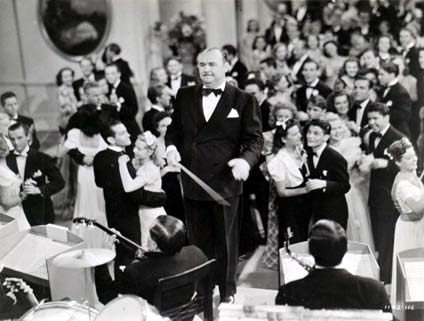
Little wonder that he would be called "the dean of modern American music."
But going back to Whiteman's own talents, what of his conducting - is it fair to compare Whiteman to directors of classical orchestras?
"I think sometimes there's been invidious comparisons made with his conducting ability, comparing him with a classical conductor and saying, well, he falls short in that area, and he did. He probably did," Rayno conceded. "But for what he needed to do, he was very good at it."
Whiteman conducting his orchestra
in the 1940 MGM motion picture "Strike Up the Band"
"He wasn't a classical conductor, in the sense of Leopold Stokowski or somebody, but he was a good bandleader and he has presence and all the musicians remarked on that, that he had the stick," Rayno said. "It wasn't that he was as technically proficient as a good classical conductor would be, but he really had the presence in front of the band and in front of the audience that commanded attention."
Would it accurate to call Whiteman a showman?
"He was a showman, but he had his talent in that sense," Rayno said. "He used a baton. He had a very long... he had, about, a three-foot baton, which was considered long for those days, maybe still is, I don't know what the size of batons are. So he did use a baton."
I recall reading at least one critic who called Whiteman's conducting "flamboyant."
"He was flamboyant," Rayno acknowledged. "He had a good ear. He could hear the wrong notes in a chord... you know, in an orchestra setting. Not everybody can do that well and spot who it is, and he was able to do that quite well. So I think his conducting was better than people think it was. And, you know, it may be that everybody has off days, and he was judged by an off day or something where comments were made. Most of the contemporary reviews seem to praise his conducting. That's for what it's worth. That's my opinion, anyway. He's a better conductor than he's given credit for."
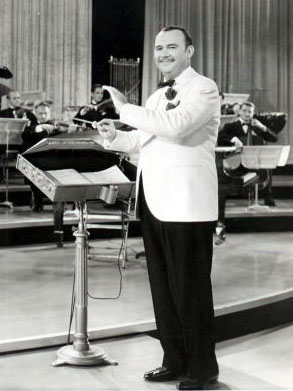
Whiteman's orchestra was signed to Victor Records in 1920, and it wasn't long before their discs became incredibly popular.
The 78 rpm disc of Whispering backed with The Japanese Sandman, for example, reportedly sold two million copies, and Three O'Clock in the Morning supposedly more than three million.
“A million records was a lot of records,” Rayno stressed.
Within a few years, by 1923, Whiteman's yearly royalties from recordings was said to be $75,000.
“I think he had a good sense, though, of what was commercial and what would sell well,” Rayno suggested. “I remember Bill Challis, one of his arrangers, told me that, that he really had a good sense of that. But he really was, uh, intrepid, in playing just a variety of styles, and really pulling it off . . . It’s really quite remarkable because, today, music and musicians and bands and so forth are so categorized – we do this or we do that, and he did a lot of different things."
Specifically, Whiteman’s orchestra played what was characterized as “symphonic jazz.”
“Yeah, that’s something that he coined,” Rayno explained. “It was the idea of taking classical music and giving it a beat. We call it ‘jazzing it up’ a little bit, making it a little more modern, contemporary, with a beat kind-of-thing. Examples of that would be (especially in the early days), of course, Rhapsody in Blue was considered a symphonic jazz piece. It has classical overtones, but it has jazzy figures in it. But he did a lot of things in the early days where he took a classical piece, or a piece from an opera, like Cho-Cho-San . . . That’s a wonderful record. That’s from “Madame Butterfly.” And he would take this, he’d make it really a popular music kind of piece. And, actually . . . there was some objections for Paul Whiteman - he would get it from both ends - the classical people said he shouldn’t be fooling with the classics and the jazz people say he can’t play jazz. So he was always in the middle. But he would take a classical piece like that and then he would really, sort of, modernize it up and give it a fresh treatment that would appeal to people today. Actually, it helped people become aware of classical beats. The layman who didn’t know about that would kind of become aware of that.”
Another example was Dance of the Hours, which Whiteman himself arranged with Love in Idleness stuck in the middle of it, as a medley.
“One of their first records," Rayno pointed out. "They called it Best Ever Medley. That’s a Ponchielli tune from the opera. He [ Whiteman ] did things like that, and they called that ‘symphonic jazz.’ Sort of a blend of the two – it wasn’t classical and it certainly wasn’t jazz . . . it’s hard to describe. You have to listen to it!”
Still another illustration would be Whiteman’s 1926 rendition of Song of India.
“There’s a bunch of them in the early period that really fit in that category,” Rayno said. “Of course, Tommy Dorsey [ later ] did Song of India, but Paul did it first as a popular piece. That’s a Rimsky-Korsakov piece. Ferde Grofe had a lot to do with that, in terms of adapting it. He would take these things and adapt them, quite successfully."
recommended listening
The Japanese Sandman
Ferde Grofe, arranger ( Victor, 1920 )
Whispering
Ferde Grofe, arranger ( Victor, 1920 )
Ty-Tee
Ferde Grofe, arranger ( Victor, 1921 )
I'll Build a Stairway to Paradise
Ferde Grofe, arranger ( Victor, 1922 )
What'll I Do?
Ferde Grofe, arranger ( Victor, 1924 )
Valencia (A Song of Spain)
Franklyn Baur, vocal / Ferde Grofe, arranger
( Victor, 1926 )
Rhapsody in Blue
George Gershwin, piano / Ferde Grofe, arranger
( Victor, 1927 )
It Won't Be Long Now
Matty Malneck, arranger ( Victor, 1927 )
Back in Your Own Backyard
Jimmy Dorsey, alto sax, and Bix Beiderbecke,
cornet / Bill Challis, arranger ( Victor, 1928 )
Sugar
Bix Beiderbecke, cornet / Bill Challis, arranger
( Victor, 1928 )
Ol' Man River
Bing Crosby, vocal / Bill Challis, arr. ( Victor, 1928 )
From Monday On Matty Malneck, arranger
( Victor, 1928 )
Lonely Melody Bill Challis, arranger ( Victor, 1928 )
Because My Baby Don't Mean "Maybe" Now
Bing Crosby, Al Rinker, Jack Fulton, Charles Gaylord &
Austin "Skin" Young, vocal / Bill Challis, arranger
( Columbia, 1928 )
Something to Remember You By
The Rondoliers Quartet, vocal ( Columbia, 1930 )
We Just Couldn't Say Goodbye Mildred Bailey,
vocal ( Victor, 1932 )
Says My Heart Joan Edwards, vocal ( "Chesterfield"
radio broadcast, Jul. 8, 1938 )
I Let a Song Go Out of My Heart
Jack Teagarden, trombone ( "Chesterfield" radio broadcast,
Aug. 17, 1938 )
Rain The Four Modernaires, vocal ( Decca, 1940 )
Trav'lin' Light Billie Holiday, vocal ( Capitol, 1942 )
Wang Wang Blues ( Capitol, 1945 )
Has Rayno considered adding a companion CD to his research?
“Well, I would like to see that,” he told me. “I thought about doing one for [ the first volume ]. I was trying to keep the cost down. The book would be large, as it was, and there’s so many recordings. There are a lot out… a lot of CDs out on the ‘20s stuff, although there’s still a lot that’s not out, he did so much.
Whiteman's eclectic recording output made his billing "The King of Jazz" - which he personally never liked - all the more awkward.
“People need to understand… sometimes they say, ‘Well, he didn’t play jazz.’ He was not a jazz bandleader," Rayno cautioned, "but he did have a band that did play some jazz. But they also played show tunes. They played waltzes. They played tangos. They played classical, or semi-classical, I guess you’d say. They played ballads. They played all kinds of different… they played novelty tunes. So it’s very hard to categorize his music. This has confounded a lot of people, because they want to be able to say, ‘Well, he wasn’t this or he wasn’t that.’ He was a little bit of everything.”
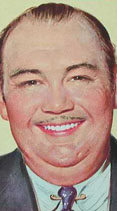
As Whiteman's music has been reissued over the decades, revisionist history has been at work, giving top billing to Crosby or Beiderbecke over Whiteman. With no disrespect meant to them, I object because they were - at the time the recordings were made - just two of many members of his ensemble.
a color drawing of Whiteman, 1933
To me, it’s the same thing that happens when Frank Sinatra’s sides with Tommy Dorsey’s band are repackaged over and over: all of a sudden, they're considered Sinatra items, even though he was simply the vocalist and Dorsey was, when they were originally done, the major star.
"Well, part of that is the whole process where the vocalists kind of eclipsed the bandleaders,” Rayno remarked. "‘Cause he’s not remembered today the way that Crosby’s remembered, for example . . . he [ Whiteman ] was very important, but he’s been forgotten, and that’s really shocking.”
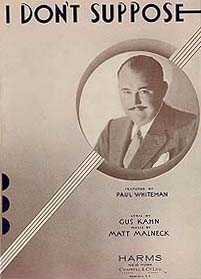
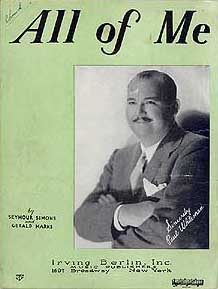
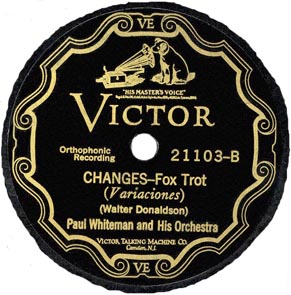
Whiteman on the cover of sheet music, 1931
It's all the more ironic since Whiteman is credited with having the first featured male singer, first girl vocalist, and first vocal group with a big band... and then they, eventually, took the music business over.
“Right, right,” Rayno agreed. “And I think part of the reason is he very much -- more than any other bandleader -- would really give room for his vocalists and musicians to take the spotlight. He had a whole thing in his concerts called ‘Meet the Boys,’ where he just gave each one the spotlight. And that just wasn’t happening with a lot of other bandleaders who were jealous of the spotlight and wanted to make sure it stayed on them. So maybe that’s one reason that he’s remained more in the background over time. He discovered Johnny Mercer, Mildred Bailey, Bix Beiderbecke, and so forth… Jack Teagarden. They became famous. Like you say, it’s a very ironic thing. "
It's also an historical fact that few African-Americans had any connection to the Whiteman orchestra.
“Yeah, because that wasn’t happening then,” Rayno offered. “It wasn’t socially permissible, unfortunately . . . But it just wasn’t the times. You traveled into the South, even really, Chris, into the ‘40s and even ‘50s, really anytime before civil rights in the early to mid-‘60s, it was tough going for a band that had a Black singer or musician when they checked into hotels in the South. There’s still stories about Nat King Cole headlining at a hotel or a theater and not being able to go in the front door or not being able to stay in the hotel where he was a star. So, yeah, it was a long time before that really straightened out.”
However, mention can be made of two African-Americans who worked for Whiteman, William Grant Still and Don Redman.
“He did hire William Grant Still and he did travel with the band, especially when they went out to make ‘The King of Jazz’ in ’29. In fact, there’s a picture in my book that you’ll see William Grant Still when they’re at Buffalo Bill Cody’s grave; he’s on the far right,” Rayno said. “He also hired . . . Don Redman to do arranging for him."
Meanwhile, some Black colleagues thought well of Whiteman.
“He was very well liked by his contemporary Black bandleaders, like Fletcher Henderson, and Duke Ellington really praised him highly. Duke, I think, went out of the way in his own book
[ Music Is My Mistress (New York City: Doubleday & Company, Inc., 1973) ], to make some statements about Paul Whiteman which were very good.”
Of course, the people who for years spoke most highly of Whiteman were the members of his own band.
"In general, Chris, also I would say that he elevated the lot of band musicians because he paid them well, it was really an honor to work for him. He paid the best, he hired the best," Rayno asserted. "So he really did elevate the lot of band musicians because the whole Union scale went up. He set the pace... especially, you see in the '20s... with the configuration of the band. He was the first to really get additional saxophones. When he got three saxophones in the early '20s, the other bands followed him. Then he went to four, and they followed him. So a lot of those kinds of things. He really was a leader in that sense. He combined really good
business and promotional sense with his music. He was not only able to have a good band, but he was able to present it and publicize it, get it booked for concerts and so forth. So he had a good business sense, as well."
Speaking of business, a lot has been made of Whiteman’s fees for playing various venues (many staggering figures for the times), up to $10,000 a night for providing entertainment at millionaires' parties. His total income in 1925, for example, was $680,000.
In 2007, are these figures important or are they now just cold business statistics?
“Well, no, I think they are important,” Rayno responded. “He was paid extremely well. He was breaking all kinds of records for theater engagements and those kinds of things. He had a big payroll, and so he had to have a pretty good amount, but he commanded it. He commanded those numbers and, typically, you see this all over the place in Variety if you’re looking back there, the pays that he got for when he was at the Palace Theatre were higher than anybody had ever had. Yeah, he kind of lead the way in that area, very much so, and held a lot of records that took a while to be broken, I think. He was in demand. I mean, the stature of this man is incredible, when you look at the fact today who would… If an entertainer came to a city, who’s big enough that the mayor would come out to meet him, give him the key to the city, and have a parade in his honor? There’s nobody like that today.”
Maybe a sports figure.
“Yeah, it would have to be another branch of entertainment, or not in music or show business, but in some other area," Rayno concurred. "His stature was just incredible – the respect and admiration that he commanded. It’s interesting to me, Chris, that so much of that’s been forgotten today, because he was just an icon of that period. There’s no question about that.”
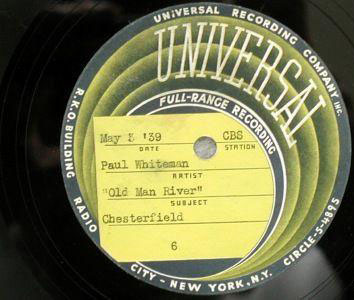
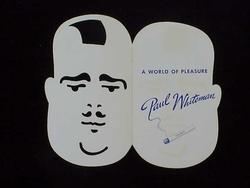
artifacts from the "Chesterfield" radio show: a card in the shape of Whiteman's "potato" head [ above ], and an acetate disc aircheck [ r. ]
But by the late 1930s, wasn't Whiteman, who was nearing 50 years old, somewhat old-fashioned to be the leader of a swing band?
“Well, his music does change,” Rayno cautioned. “That’s something I hope to point out in my second volume. He had a good band, like ’38 and ’39… he had a very good band that played for the Chesterfield radio program. [ It was ] extremely good: he had Jack Teagarden, for example. He had George Wettling on drums. He had, really, some great, great players. But he was older by then, and these young guys, like the Dorseys (that played with him) and others became quite popular. The thing that they had, if you look at that (well, maybe with the exception of Glenn Miller)… a lot of those guys then - Benny Goodman, Artie Shaw, the Dorseys (together and with their own bands) – they were real solo stars in their own right. So there was a nice showcase there. Harry James on trumpet and so forth. Paul didn’t really have that. His band was the star, not him. So there was a difference there. I did read a review from George Simon; I think it was in Metronome. He reviewed the Whiteman band in ’39, and he gave it a big thumbs up, as far as [ being ] a swinging band. And I’ve talked with some of the musicians from that band, and that was a really swinging band and the records are good.”
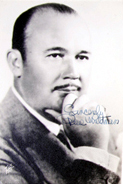
Paul Whiteman in his own words
"You'll never learn to bounce in jazz if you don't know your Bach and Beethoven."
"I never believed that jazz was as bad as the symphonists thought it was, nor that symphony was as bad as the jazz lovers thought it was . . . I thought there ought to be a common ground-and 'Rhapsody' found it."
"The leaders of big bands . . . finally taught the world to sit around and listen to the singers . . . The singers would never have happened if they hadn't been showcased by the big bands."
"Too often . . . musicians play for other musicians. They show off their technical skill, flashy technique. This may be great to another musicians: it doesn't mean a thing to the public. Often, it bores the public. Guy Lombardo, for instance, has stuck to his last. He's played music you can dance to or listen to and he's done better than most."
Rayno, now 51, did an excellent job of writing in Volume 1, and, in my opinion, his book set a new standard of detailed research.
"Oh, thank you so much. It's been a labor of love," he said. "I'm fairly young, as far as this era would go, I guess. When I grew up, my father played piano around the house, and he played a lot of the old songs from the big band era . . . As I became a teenager, I became interested in the vocalists of the big band era and [ the ] early '50s as well."
Bing Crosby became a particular favorite.
"I, sort of, studied his life, and that, of course, led me to Whiteman because he got his start with Whiteman," he explained. "I began to look at what Whiteman did, and thought, 'Well, this is just utterly remarkable!' All the people that came up through his band and what he did. So I really started as a hobby, more than anything."
That was more than 25 years ago, around 1983.
"I just was researching his life and got more and more interested in it, and it eventually became a book," he recalled. "That's how I first fell into it - it was really looking through the life of Bing Crosby."
Around the same time when Rayno was beginning his investigation, Thomas DeLong's full-length biography of Whiteman, Pops: Paul Whiteman, King of Jazz (Piscataway, NJ: New Century Publishers, 1983), was published.
"Well, it came out and I realized there's still a lot more that could be said," Rayno commented. "I was just starting at that point, and maybe within a few months, that book came out. And I read that, and that just, sort of, spurred my interest further."
In fact, he became friends with DeLong.
"Tom actually has been quite helpful," he noted. "Led me to a lot of band members that were still living and that kind of thing."
Rayno also was able to visit The Paul Whiteman Collection, which the bandleader had established in 1936 at Williams College in Massachusetts.
"And that was like 'a kid in a candy shop,'" he remarked. "I realized, 'Wow! There's so much more information that can be written about!'"
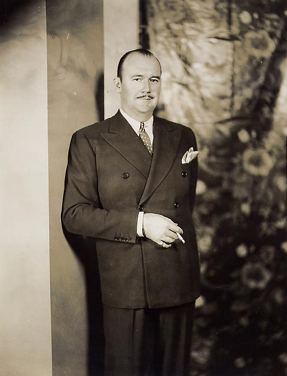
He told me that one of Whiteman’s granddaughters, Cindy Magill, who is in her early 50s, has shown a real interest in his legacy.
“She was extremely helpful and extremely supportive in the first volume, and really even more so now, as we’re getting into the later years,” Rayno said.
In preparation for writing this biographical sketch, I felt privileged to briefly speak with Cindy, too.
“I came to live with my grandparents when I was 3 years old. I was raised by them, from the time I was 3," she began. "And most of what I remember is my grandfather being horrified that American children were being raised with no understanding of their own heritage. He said, ‘I think it’s just great to understand the Europeans and everything else and obviously that’s where we all came from, but they need to understand their own heritage. They need to be proud of what is being done right here.’
"And he was trying to set up an American music curriculum in colleges across the country, and that was my generation of living with him," Cindy continued. "And then, after that, I kind of saw really nothing about American music in schools and I have children who are now 19 and 21. They went to a very good school system and are in very good colleges, but there was no American music curriculum. And I think about that passion of his, and how sad that is, and then I see something like the work that Don did, and I think, ‘You know what? There are people out there who are still trying to champion [ Whiteman's interests ].'"
What was Whiteman like as a person - as a grandfather?
“The sad fact of the matter is I don’t get asked that question very much,” Cindy remarked. “Most people who contact me want to know more about what I know about the music or whatever. As a human being and what it was to be raised by him, this kind of goes back to Don. Don was just here this past weekend with us. He was interviewing some people in the area and working with me. There was something he needed . . . and I knew that it was in a trunk in the attic. This is a trunk that I’ve been in and out of a thousand times when people want things that I have, but that I don’t go to on a daily basis. I went up there and on the very top of the trunk was this [ unlabeled ] cassette and I thought, ‘Oh my God! That’s so strange! How did that get there?’ Because I’ve never seen it before. So I . . . took it out and stuck it in my pocket and rifled through and found what Don needed and I came down and I said to him, ‘Do you have a cassette recorder?’ because I don’t think I own one. And he said, ‘Yeah, I do.’ And I shoved this in there and it was a tape that my grandfather must have been giving some interview, and it’s a complete tape but there’s, maybe, only four minutes on it. So for four minutes, he’s talking about me when I was a little girl. And it was the strangest thing, ‘cause I hear his voice often and it just kind of gives me the chills. And I don’t know if you’ve had that experience… to go back and look at a family video or listen to a tape of somebody you loved and their voice. It’s always a little freaky. It just brought back like this tumbling down of memories to me, and he was just the most loving, wonderful, supportive person in the world. I was saying to Don, ‘You know, at the point that I came to live with him, I was 3. My sister was 3 months. My brother was 6. They could have very easily a) not even bothered but, being the people they were, obviously they would. They could have planted us in one of the places that they resided in with a nanny and a caretaker and gone on their merry way, and they didn’t. They just dragged us with them everywhere they went. Be it the East Coast or West Coast or anything in-between, we were very much a part of their lives. They kept us very away from all the hoop-de-hoo and falderal. It wasn’t until I was much older that I realized that all of the people that were in our house, all the families we contact with were people that other people considered, quote – unquote, ‘famous.’ Because they just very much wanted us to have this lovely, normal existence and he was passionate about protecting us. We weren’t subjected to any kind of public displays . . . I can’t say enough about the loving, warm, kind person he was. We had our house here… ‘cause we lived in several places… the house they had in Saulberry, his room entered out onto this cool patio kind of area and the garden and blah-blah-blah. And as young kids we would have parties out there. As young kids, you always had to have a little band that was made up of, in my case, 10, 12, 14, 16-year olds. And he would stare and listen and I remember adult friends of his who would come and go, ‘I don’t know how you stand this.’ And he would just always say, ‘They’re developing. Give ‘em a chance!’ And so that’s the person I knew.”
Whiteman Orchestra necrology - select list
( dates shown are years of employment with Whiteman )
Roy Bargy, 79, pianist - arranger ( 1928-1940 ), d.Jan. 16, 1974
Bix Beiderbecke, 28, cornetist ( 1927-1929 ), d.Aug. 6, 1931
Bill Challis, 90, arranger ( 1927-1930 ), d.Oct. 4, 1994
Kurt Dieterle, 95, violinist ( 1924-1935 ), d.Nov. 13, 1994
Morton Downey, 83, vocalist ( 1924-1925 ), d.Oct. 25, 1985
Goldie Goldfield, 50, trumpeter - comic ( 1928-1937 ), d.May 19, 1948
Ferde Grofe, 80, arranger - composer ( 1919-1931 ), d.Apr. 3, 1972
Eddie Lang, 30, guitarist ( 1929-1930 ), d.Mar. 26, 1933
Matty Malneck, 77, violinist - arranger ( 1926-1936 ), d.Feb. 25, 1981
Charlie Margulis, 64, trumpeter ( 1927-1930 ), d.Apr. 24, 1967
Mike Pingatore, 64, banjoist ( 1919-1940s ), d.Oct. 30, 1952
Bill Rank, 74, trombonist ( 1927-1938 ), d.May 21, 1979
Al Rinker, 74, vocalist ( 1926-1930 ), d.June 11, 1982
Andy Secrest, 70, trumpeter ( 1929-1933 ), d.Aug. 31, 1977
William Grant Still, 83, arranger ( 1929-1930 ), d.Dec. 3, 1978
Charles Strickfaden, 81, saxophonist ( 1924-1937 ), d.Sept. 11, 1981
Frankie Trumbauer, 55, saxophonist ( 1927-1932 ), d.June 11, 1956
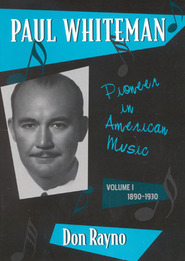
Rayno's first volume
“I guess the more I delve into his life, what has been remarkable to me is that he remained a very warm human being, after all his fame,” Rayno concluded. “He had a very tender heart, he was very generous, and he never changed in that area. So many times you see that, but he really did. I keep talking to musicians who tell me that, reading about it, talking with his family, with his granddaughter how wonderful a grandfather he was, and so forth. So the human side of him… I won’t say it surprised me, Chris, but it delighted me.”
Rayno must have spent countless hours studying Whiteman's life and career.
"Thousands, Chris, I'm sure," he estimated. "Of course, a lot of the research will help me for Volume 2, too. So it won't be that long."
sources
Laurent, Lawrence. "Watch for Big Bands, Says Paul Whiteman," Washington Post and Times Herald,
July. 17, 1955, p.J3.
Magill, Cindy. Telephone interview with author, Apr. 15, 2005.
"Musical 'Great' Paul Whiteman Dies of Heart Attack at 76," Hartford Courant, Dec. 30, 1967, p.6.
"Obituaries: Margaret Livingston," New York Times, Jan. 16, 1985, p.B5.
"Paul Whiteman, 76 [ sic ], 'King of Jazz,' Dies," Los Angeles Times, Dec. 30, 1967, p.1.
"Paul Whiteman Asks Divorce: 'King of Jazz' Files 'Friendly' Suit," Los Angeles Times, Feb. 28, 1931,
p.3.
"Paul Whiteman Dies," DownBeat, Feb. 8, 1968, p.13.
"Paul Whiteman Has Done Much for American Dance Music," Boston Daily Globe, Feb. 4, 1923, p.46.
"Paul Whiteman, King in Land of Jazz, Relates How He Rose to the Throne: Believes Jazz Versions of
Classical Selections Have Taught General Public to Like and Appreciate Originals," Hartford Courant,
May 23, 1926, p.D5.
"Paul Whiteman Plans Rock'N'Roll Concert," Hartford Courant, June 30, 1956, p.7B.
Rayno, Don. Paul Whiteman: Pioneer in American Music, Volume 1 1890-1930 (Lanham, MD:
The Scarecrow Press, Inc., 2003).
---. Telephone interview with author, Apr. 15, 2005.
"Paul Whiteman's Mother Dies in Denver At 68," Chicago Daily Tribune, June 27, 1934, p.14.
"Paul Whiteman's Sister Dies," New York Times, Dec. 26, 1953, p.13.
Whitman, Alden. "Paul Whiteman, 'the Jazz King' Of the Jazz Age, Is Dead at 77," New York Times,
Dec. 30, 1967, p.1, col.5.
"Whiteman, Paul," in Who Is Who in Music (Chicago: Who Is Who in Music, Ltd., 1951).
Whiteman, Paul. "The Place I Like Best: A New Jersey 'ranch' is home to Paul Whiteman!,"
Hartford Courant, Oct. 15, 1950, p.G4.
send feedback about "Paul Whiteman: Something to Remember You By" via e-mail
return to Biographical Sketches directory
go to Big Band Library homepage
FEEDBACK AND FOLLOW-UP
I can't say enough good things about it.
I'm hard at work on volume 2, about half done, now.
My pace has picked up, but it is at least a year away
from being finished. It will be another large volume,
[ with ] much new information . . . "
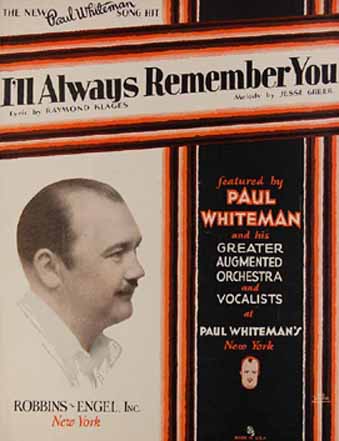
"But he just, sort of, liked to be ‘one of the boys.’ He preferred that, than to be, sort of, singled out as a celebrity," Rayno claimed.
"In fact, his granddaughter was telling me that, part of the time when he retired, they lived in Palm Springs, California and part of the time in New Hope . . . sort of, half and half of the year. And a restaurant in Palm Springs wanted him to just come… they said they’d pay him to come every day and just sit at a table, where people could see him. And he said, ‘I don’t want to be on display like I’m a museum piece.’ So he just really never liked that part of it, I don’t think.”
I wondered if that was the time where someone asked him, "How old are you?" and Whiteman said, "Not half as old as the steak you served me!"
“It might have been, I forget,” Rayno laughed. “That’s in Tom’s book. He
[ Whiteman ] had a really witty, clever sense of humor. He had a language all his own… his own lexicon. I’ll try to get more of that in the second book. He really was amusing to musicians in the things that he said.”